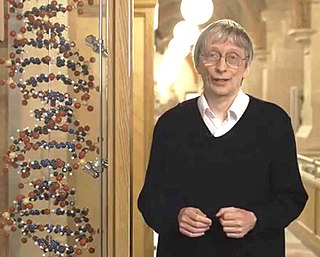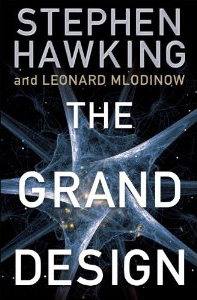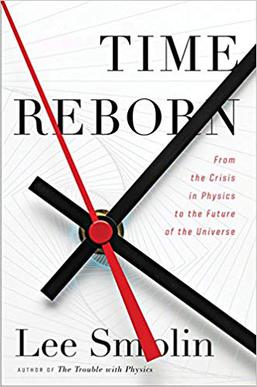Related Research Articles
The anthropic principle, also known as the "observation selection effect", is the hypothesis, first proposed in 1957 by Robert Dicke, that the range of possible observations that we could make about the universe is limited by the fact that observations could only happen in a universe capable of developing intelligent life in the first place. Proponents of the anthropic principle argue that it explains why this universe has the age and the fundamental physical constants necessary to accommodate conscious life, since if either had been different, we would not have been around to make observations. Anthropic reasoning is often used to deal with the notion that the universe seems to be finely tuned for the existence of life.

David Elieser Deutsch is a British physicist at the University of Oxford. He is a Visiting Professor in the Department of Atomic and Laser Physics at the Centre for Quantum Computation (CQC) in the Clarendon Laboratory of the University of Oxford. He pioneered the field of quantum computation by formulating a description for a quantum Turing machine, as well as specifying an algorithm designed to run on a quantum computer. He has also proposed the use of entangled states and Bell's theorem for quantum key distribution and is a proponent of the many-worlds interpretation of quantum mechanics.

The many-worlds interpretation (MWI) is an interpretation of quantum mechanics that asserts that the universal wavefunction is objectively real, and that there is no wave function collapse. This implies that all possible outcomes of quantum measurements are physically realized in some "world" or universe. In contrast to some other interpretations, such as the Copenhagen interpretation, the evolution of reality as a whole in MWI is rigidly deterministic and local. Many-worlds is also called the relative state formulation or the Everett interpretation, after physicist Hugh Everett, who first proposed it in 1957. Bryce DeWitt popularized the formulation and named it many-worlds in the 1970s.

Erwin Rudolf Josef Alexander Schrödinger, sometimes written as Schroedinger or Schrodinger, was a Nobel Prize-winning Austrian and naturalized Irish physicist who developed a number of fundamental results in quantum theory: the Schrödinger equation provides a way to calculate the wave function of a system and how it changes dynamically in time.

Physics is the natural science of matter, involving the study of matter, its fundamental constituents, its motion and behavior through space and time, and the related entities of energy and force. Physics is one of the most fundamental scientific disciplines, with its main goal being to understand how the universe behaves. A scientist who specializes in the field of physics is called a physicist.

Paul Adrien Maurice Dirac was an English theoretical physicist who is regarded as one of the most significant physicists of the 20th century. He was the Lucasian Professor of Mathematics at the University of Cambridge, a professor of physics at Florida State University and the University of Miami, and a 1933 Nobel Prize in Physics recipient.

A theory of everything, final theory, ultimate theory, unified field theory or master theory is a hypothetical, singular, all-encompassing, coherent theoretical framework of physics that fully explains and links together all aspects of the universe. Finding a theory of everything is one of the major unsolved problems in physics. String theory and M-theory have been proposed as theories of everything.

In the philosophy of space and time, eternalism is an approach to the ontological nature of time, which takes the view that all existence in time is equally real, as opposed to presentism or the growing block universe theory of time, in which at least the future is not the same as any other time. Some forms of eternalism give time a similar ontology to that of space, as a dimension, with different times being as real as different places, and future events are "already there" in the same sense other places are already there, and that there is no objective flow of time.

In philosophy, philosophy of physics deals with conceptual and interpretational issues in modern physics, many of which overlap with research done by certain kinds of theoretical physicists. Philosophy of physics can be broadly divided into three areas:
Lee Smolin is an American theoretical physicist, a faculty member at the Perimeter Institute for Theoretical Physics, an adjunct professor of physics at the University of Waterloo and a member of the graduate faculty of the philosophy department at the University of Toronto. Smolin's 2006 book The Trouble with Physics criticized string theory as a viable scientific theory. He has made contributions to quantum gravity theory, in particular the approach known as loop quantum gravity. He advocates that the two primary approaches to quantum gravity, loop quantum gravity and string theory, can be reconciled as different aspects of the same underlying theory. He also advocates an alternative view on space and time he calls temporal naturalism. His research interests also include cosmology, elementary particle theory, the foundations of quantum mechanics, and theoretical biology.
The Dirac Medal is the name of four awards in the field of theoretical physics, computational chemistry, and mathematics, awarded by different organizations, named in honour of Professor Paul Dirac, one of the great theoretical physicists of the 20th century.
Jorge Pullin is an American theoretical physicist known for his work on black hole collisions and quantum gravity. He is the Horace Hearne Chair in theoretical Physics at the Louisiana State University.
The Big Bounce is a hypothesized cosmological model for the origin of the known universe. It was originally suggested as a phase of the cyclic model or oscillatory universe interpretation of the Big Bang, where the first cosmological event was the result of the collapse of a previous universe. It receded from serious consideration in the early 1980s after inflation theory emerged as a solution to the horizon problem, which had arisen from advances in observations revealing the large-scale structure of the universe. In the early 2000s, inflation was found by some theorists to be problematic and unfalsifiable in that its various parameters could be adjusted to fit any observations, so that the properties of the observable universe are a matter of chance. Alternative pictures including a Big Bounce may provide a predictive and falsifiable possible solution to the horizon problem, and are under active investigation as of 2017.
Julian Barbour is a British physicist with research interests in quantum gravity and the history of science.

A physical paradox is an apparent contradiction in physical descriptions of the universe. While many physical paradoxes have accepted resolutions, others defy resolution and may indicate flaws in theory. In physics as in all of science, contradictions and paradoxes are generally assumed to be artifacts of error and incompleteness because reality is assumed to be completely consistent, although this is itself a philosophical assumption. When, as in fields such as quantum physics and relativity theory, existing assumptions about reality have been shown to break down, this has usually been dealt with by changing our understanding of reality to a new one which remains self-consistent in the presence of the new evidence.

The Grand Design is a popular-science book written by physicists Stephen Hawking and Leonard Mlodinow and published by Bantam Books in 2010. The book examines the history of scientific knowledge about the universe and explains eleven-dimensional M-theory. The authors of the book point out that a Unified Field Theory may not exist.
Tim William Eric Maudlin is an American philosopher of science who has done influential work on the metaphysical foundations of physics and logic.

Time Reborn: From the Crisis in Physics to the Future of the Universe is a 2013 book by the American theoretical physicist Lee Smolin.
In theoretical physics, the problem of time is a conceptual conflict between general relativity and quantum mechanics in that quantum mechanics regards the flow of time as universal and absolute, whereas general relativity regards the flow of time as malleable and relative. This problem raises the question of what time really is in a physical sense and whether it is truly a real, distinct phenomenon. It also involves the related question of why time seems to flow in a single direction, despite the fact that no known physical laws at the microscopic level seem to require a single direction. For macroscopic systems the directionality of time is directly linked to first principles such as the second law of thermodynamics.
The timeless universe is the philosophical and ontological view that time and associated ideas are human illusions caused by our ordering of observable phenomena. Unlike most variants of presentism and eternalism, the timeless universe entirely rejects the notion of the reality of any time, arguing that it is exclusively a human illusion, and since the universe can know no time, no dimension of time can be permitted in any theoretical explanation of parts of the observable universe. All purported measurements of time must hence according to this view be correlation measurements between movements, as stated by physicist Ernst Mach in 1883:
It is utterly beyond our power to measure the changes of things by time. Quite the contrary, time is an abstraction at which we arrive by means of the changes of things; made because we are not restricted to any one definite measure, all being interconnected.
References
- ↑ See the section "Editions".
- ↑ Barbour J., Preface.
- ↑ Dirac P., "The Evolution of the Physicist’s Picture of Nature", Scientific American , May 1963.
- ↑ Barbour J., p. 46; the example reappears p. 310.
- ↑ Commenting on his "Quantum mechanics for cosmologists", Barbour writes that "his proposal is very close to mine in two of its three main elements. He may have believed in time, but his emphasis on memories and records and their rather natural occurrence in the quantum context are valuable support for me. So are his views on ontology and psychophysical parallelism. This is the third common element" (p. 301). See also Bell J., Speakable and Unspeakable in Quantum Mechanics, Cambridge University Press, 1988, ISBN 978-0521368698.
- ↑ Ismael, Jenann (2002). "Rememberances, mementos, and time-capsules". In Craig Callender (ed.). Time, Reality & Experience. Royal Institute of Philosophy Supplement. Vol. 50. New York: Cambridge University Press. pp. 317–328.
- ↑ Butterfield, Jeremy (2002). "Julian Barbour, the End of Time: The Next Revolution in Our Understanding of the Universe. London: Weidenfeld and Nicolson, 1999. ISBN 0 297 81985 2". The British Journal for the Philosophy of Science. 53 (2): 289–330. arXiv: gr-qc/0103055 . doi:10.1093/bjps/53.2.289.
- ↑ Barbour, Julian (2009). "The Nature of Time". arXiv: 0903.3489 [gr-qc]. Referring to his book, Barbour states that "using a few elementary equations and some new arguments, I wish to strengthen the case for eliminating time as a fundamental concept in classical physics". Further work has been uploaded at this site.